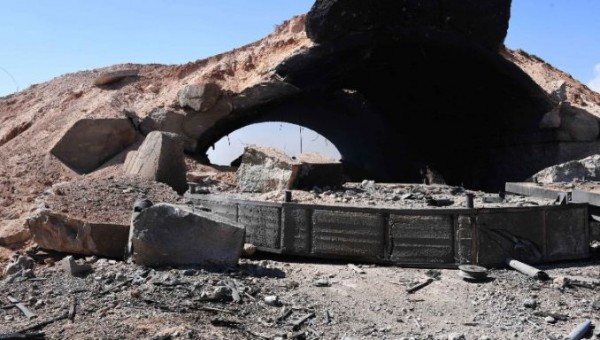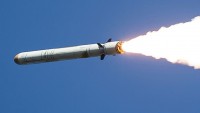US Tomahawk Cruise Missiles Send Deadly Message to America’s Foes with Attack on Syria
| Arthur Dominic Villasanta | | Apr 07, 2017 10:53 PM EDT |
(Photo : TASS) Destroyed concrete aircraft shelter at Shayrat Air Base.
(Photo : US Navy) Aftermath of Tomahawk cruise missile strike on Shayrat Air Base.
The United States has again turned to the U.S. Navy and a classic navy weapon -- the UGM-109E Tomahawk Land Attack Missile (TLAM) -- to uphold U.S. interests, this time with a massive strike at the Syrian airfield whose planes launched the April 4 poison gas attack on the town of Khan Shaykhun in Idlib province that killed at least 74 people, including many children
Like Us on Facebook
U.S. President Donald Trump used the poison gas attack as justification for the second use of navy Tomahawks in just the past six months. On Oct. 12, 2016, the USS Nitze (DDG-94) launched five Tomahawk cruise missiles to destroy three coastal radar sites operated by Houthi rebels in southern Yemen.
On Oct. 9, the Houthis fired Chinese-made C-802 ASMs anti-ship missiles at the USS Mason (DDG-87), which was patrolling the Bab al-Mandeb Strait. The Pentagon said the radar stations attacked were involved in the attack against the Mason.
This time in Syria, the Pentagon announced that 59 Tomahawks were fired from two navy destroyers in the Mediterranean Sea. The USS Ross (DDG-71) fired 36 Tomahawks while the USS Porter (DDG-78) launched 23.
The target of this massive precision attack was the Shayrat Air Base in western Syria, one of the major airbases operated by the Syrian Arab Air Force and one that houses a chemical weapons storage depot.
Shayrat Air Base is home to the Syrian Arab Air Force 50th Air Brigade and its attached three fighter squadrons. It has two runways and around 40 hardened shelters.
The two Arleigh Burke-class destroyers launch their Tomahawks at 8:40 p.m. ET (3:40 a.m. local time) on April 7. The missiles hit aircraft, concrete hangars, petroleum and logistical storage, ammunition supply bunkers, air defense systems, and "the things that make the airfield operate," said Pentagon spokesman Capt. Jeff Davis.
"Initial indications are that this strike has severely damaged or destroyed Syrian aircraft and support infrastructure and equipment at Shayrat Airfield, reducing the Syrian government's ability to deliver chemical weapons," said the Pentagon in a statement.
At least 58 of the 59 Tomahawks struck the airfield, and "severely degraded or destroyed" their intended targets, said a ranking defense official quoted by American media. A more extensive battle damage assessment is underway to determine the exact extent of damage to the airfield.
U.S. Secretary of State Rex Tillerson said the administration felt the strike was "proportional because it was targeted at the facility that delivered this most recent chemical attack."
Tillerson said the U.S. has a "very high level of confidence" the Syrian regime of Bashar al-Assad carried out at least three attacks in recent weeks, including the April 4 attack where Sarin poison gas was used.
The Pentagon has not ruled out further Tomahawk strikes against Assad's regime, which is backed by Russia. Russia is now being accused of being complicit in the April 4 attack, and might have supplied the Sarin poison gas used in this inhuman attack on helpless civilians and the hospital.
The Tomahawk entered service with the U.S. military in 1983. The version used in the punitive strike on Shayrat was likely the latest version of this missile: the Block IV TLAM-E, which was deployed a decade ago.
Block IV TLAM-E is armed with a 450 kg unitary warhead it can carry to a maximum range of 1,600 km. It flies at the subsonic speed of 880 km/h. The main contractor for the Tomahawk is Raytheon Systems Company in Arizona.
Tomahawks were first fired in anger during the 1991 Gulf War. In this war against Iraq, 288 Tomahawks were launched: 276 from surface ships and 12 from submarines. During the 2003 invasion of Iraq, over 802 Tomahawk missiles were fired at key Iraqi targets.
The navy has a stockpile of around 3,500 Tomahawks of all variants as of 2015.
TagsU.S. Navy, UGM-109E Tomahawk Land Attack Missile (TLAM), Syria, President Donald Trump, Uss Ross, USS Porter, Shayrat Air Base
©2015 Chinatopix All rights reserved. Do not reproduce without permission
EDITOR'S PICKS
-

Did the Trump administration just announce plans for a trade war with ‘hostile’ China and Russia?
-

US Senate passes Taiwan travel bill slammed by China
-

As Yan Sihong’s family grieves, here are other Chinese students who went missing abroad. Some have never been found
-

Beijing blasts Western critics who ‘smear China’ with the term sharp power
-

China Envoy Seeks to Defuse Tensions With U.S. as a Trade War Brews
-

Singapore's Deputy PM Provides Bitcoin Vote of Confidence Amid China's Blanket Bans
-

China warns investors over risks in overseas virtual currency trading
-

Chinese government most trustworthy: survey
-

Kashima Antlers On Course For Back-To-Back Titles
MOST POPULAR
LATEST NEWS
Zhou Yongkang: China's Former Security Chief Sentenced to Life in Prison

China's former Chief of the Ministry of Public Security, Zhou Yongkang, has been given a life sentence after he was found guilty of abusing his office, bribery and deliberately ... Full Article
TRENDING STORY

China Pork Prices Expected to Stabilize As The Supplies Recover

Elephone P9000 Smartphone is now on Sale on Amazon India

There's a Big Chance Cliffhangers Won't Still Be Resolved When Grey's Anatomy Season 13 Returns

Supreme Court Ruled on Samsung vs Apple Dispute for Patent Infringement

Microsoft Surface Pro 5 Rumors and Release Date: What is the Latest?














